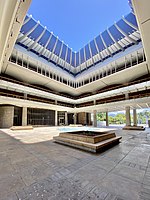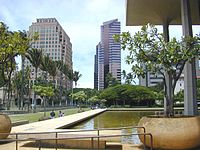Hawaii State Capitol
This article needs additional citations for verification. (August 2012) |
| Hawaii State Capitol | |
|---|---|
State of Hawaii | |
| Design and construction | |
| Architect(s) | Belt, Lemmon & Lo and John Carl Warnecke & Associates[1] |
| Website | |
| www | |
Hawaii State Capitol & Grounds | |
| Part of | Hawaii Capital Historic District (ID78001020) |
| Designated CP | 12/01/1978 |
The Hawaii State Capitol is the official statehouse or capitol building of the
Located in
Monuments
Burns designed the restoration of the royal palace built by
Several other capitol building monuments decorate the statehouse grounds. The Beretania Street entrance features the Liberty Bell, a gift of the
The Eternal Flame on Beretania Street is a metal sculptured torch that burns endlessly as a tribute to all men and women from Hawaii who served with the
Architecture
The Hawaii State Capitol is an American adaptation of the Bauhaus style termed "Hawaiian international architecture". It was designed by a partnership between the firms of Belt, Lemon and Lo (Architects Hawaii Ltd.), and John Carl Warnecke and Associates. Unlike other state capitols modeled after the United States Capitol, the Hawaii State Capitol's distinct architectural features symbolize various natural aspects of Hawaii. Among them:
- The building is surrounded by a reflecting pool, symbolizing the Pacific Ocean.
- The two legislative chambers are cone-shaped, symbolizing volcanoes that formed the Hawaiian Islands.
- The columns around the perimeter of the building have shapes resembling royal palm trees. There are eight columns in four rows at either side of the building, representing the eight main islandsof Hawaii; sets of eight items appear in other places inside and along the outside of the building.
- The Capitol is built with an open-air design, allowing sun, wind, and rain to enter; the central atrium opens to the sky and rainbows can sometimes be seen inside the building when it rains.
- Four kukui nut trees (Hawaii's state tree) are a numerical reference to the four main counties in the State of Hawaii and the four major Hawaiian gods (Kukailimoku, Kane, Lono, and Kanaloa).[2] Sets of four items appear in many other places in the building.
- When standing in the center of the structure, the chandeliers from both legislative chambers, which represent the sun and moon, can be seen through the glass walls, while the area that is normally reserved for a rotunda in most capitol buildings is left open to the sky. It is said that the sky is Hawaii's capitol dome.
- German-American artist Otto Piene designed the chandeliers, which are kinetic sculptures made of small objects. The Sun chandelier in the House is made of dozens of gold-plated globes, and the Moon chandelier in the Senate is made of 620 white chambered nautilus shells.[2]
-
The Hawaii State Capitol is on Beretania Street.
-
The central atrium
-
Statue of Father Damien outside the Hawaii State Capitol Building
-
Statue ofQueen Liliʻuokalanion the opposite side of the building
-
Reflecting pool
-
Hawaii State Capitol photographed from the rim of Punchbowl Crater
Reflecting pool algae issue
From the time the Capitol was completed in 1969, the reflecting pool has had a persistent algae growth problem, due partly to the fact the pool is fed with brackish water from on-site wells. Attempts by the state to fix the problem included introducing tilapia fish into the pool and installing an ozone treatment system.[3] The state currently has the pool lining scrubbed manually with enzymes added to the water to combat growth. Some Capitol regulars say the algae growth has come to represent the pollution of the Pacific Ocean, in an ironic twist of the original symbolic meaning of the pool.[4]
See also
Citations
- ^ a b c "Hawaii State Capitol". Docomomo International. Retrieved April 27, 2012.
- ^ a b Tsutsumi, Cheryl Chee (January 14, 2018). "State Capitol Awash with Meaning". Honolulu Star-Advertiser. Retrieved July 19, 2019 – via the Historic Hawai'i Foundation.
- ^ Bernardo, Rosemarie (May 12, 2004). "Capitol looking for fix to pools' algae problem". Honolulu Star-Bulletin. Retrieved February 4, 2008.
- ^ Novak, Candice (March 5, 2007). "Algae defeats state at Capitol pool". Honolulu Star-Bulletin. Archived from the original on July 6, 2008. Retrieved February 4, 2008.






